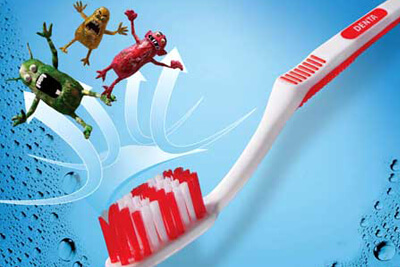
 You may have heard the new recently, but this year’s flu season is record-breaking. The flu season varies from year to year, but typically stretches from fall to winter. The peak of flu season is January and February. That’s right – we are in midst of it all. That being said, toothbrushes are a fertile breeding ground for a number of strains of viruses and bacteria including the ones that cause the common cold and influenza.
You may have heard the new recently, but this year’s flu season is record-breaking. The flu season varies from year to year, but typically stretches from fall to winter. The peak of flu season is January and February. That’s right – we are in midst of it all. That being said, toothbrushes are a fertile breeding ground for a number of strains of viruses and bacteria including the ones that cause the common cold and influenza.
Your mouth is home to millions of bacteria so cleaning your toothbrush makes sense if you want to prevent illness. If you are like most people, you are reminded each morning of the millions of bacteria growing in our mouths. After all, that’s one of the reasons we brush our teeth every morning. But where do those germs go? Yes, some of them go down the drain, but far too many of them remain on our toothbrushes.
Being aware of your toothbrush and cleaning it thoroughly will help you get through this winter’s cold and flu season a little healthier. We thought it might be helpful to share some simple advice to help keep a healthier mouth and hopefully keep you and your family well during cold and flu season.
To protect your toothbrush from bacteria now and all year long, here’s some easy tips:
- Wash your hands before and after brushing
- Be smart – keep a spare. Replace your toothbrush at least every 1-2 months or when the bristles are frayed or worn.
- If you use and electric toothbrush, the heads are replaceable and can be cleaned and disinfected in the same way as a conventional toothbrush.
- Rinse your toothbrush with water to remove toothpaste and debris after each use, and store upright to air-dry.
- Never cover the toothbrush or place in a closed container while still wet, as this will allow for the growth of more bacteria.
- Never store household members’ toothbrushes together in a drawer or cabinet.
- Always replace your toothbrush after a cold or flu because germs can linger on your toothbrush bristles, and you risk prolonging your sickness by continuing to use the same toothbrush.
- If your toothbrush is next to a sick person’s toothbrush, those sneaky cold-germs are just a hop, skip and a jump away from making you sick, too. Quarantine the sick-toothbrush in a separate drawer so that it doesn’t infect healthy brushes. If possible, consider using throw-away brushes for a week or two until the sickness has passed.
There’s even more that you can do – clean and your toothbrush thoroughly at least once a week. Here’s a few way to do that:
- Soak your toothbrush in antibacterial mouthwash. Rinse thoroughly before using again.
- Purchase a UV toothbrush sanitizer. These nifty gadgets work by combining steam with dry heat to sanitize your toothbrush. However if you don’t want to spend the money, studies show that soaking your toothbrush in Listerine works almost just as well.
We hope these easy tips are useful to you. As always, we are here to assist patients. If you have additional questions or concerns, contact us at the office and we can help to answer them.





